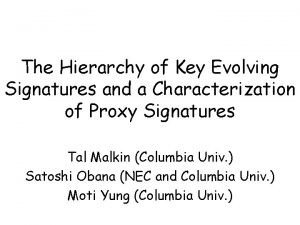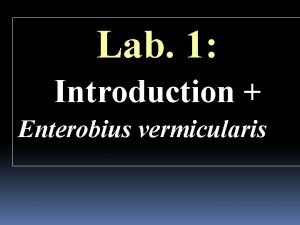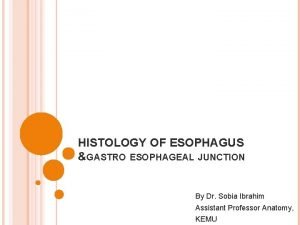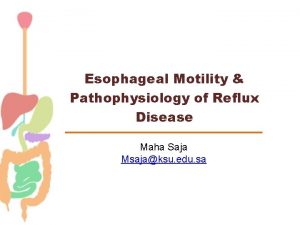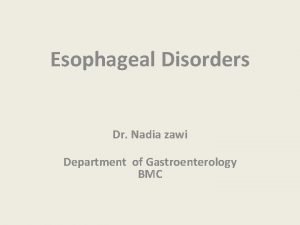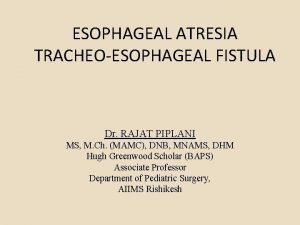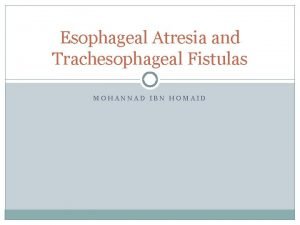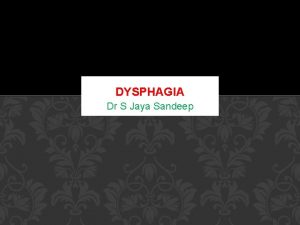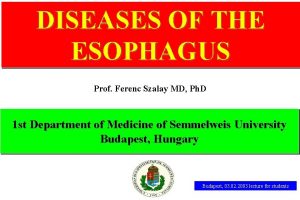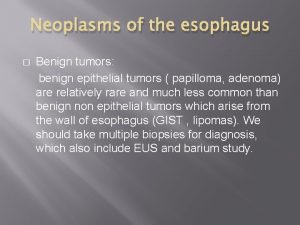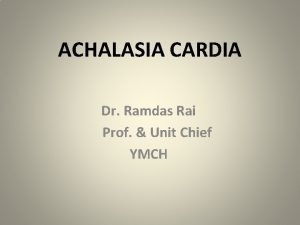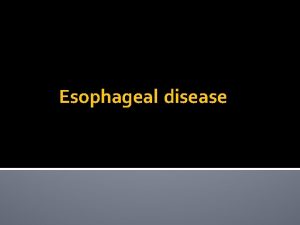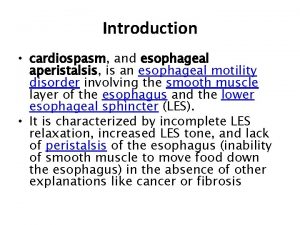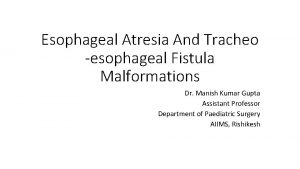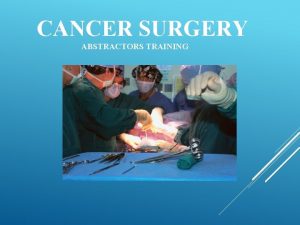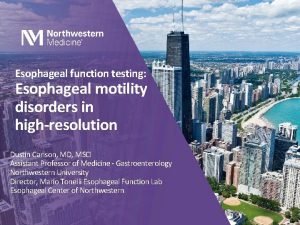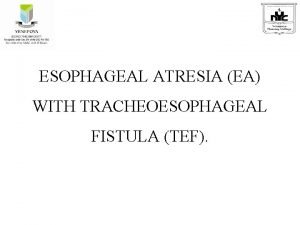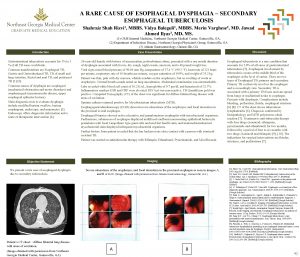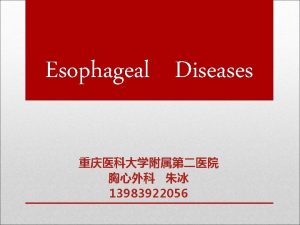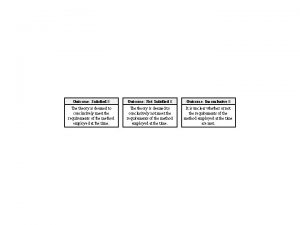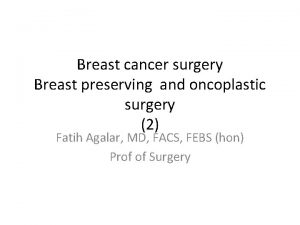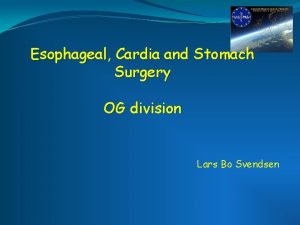Evolving concepts and outcome in esophageal cancer surgery



















- Slides: 19

Evolving concepts and outcome in esophageal cancer surgery- a single center experience from the past to present D. Kröll, S. Erdem, L. Noser, D. Arnold, F. Storni, B. Dislich, R. Langer, D. Candinas, C. A. Seiler Department of Visceral Surgery and Medicine Department of Pathology

Background I -Perioperative morbidity and mortality - Modified surgical techniques with increased numbers of dissected lymph nodes -Neoadjuvant treatment concepts Øhave led to better outcomes in locally advanced esophageal cancer during the last decades

Background II However debates regarding surgical techniques (open vs min. invas. ) and its influence on morbidity + mortality + oncological outcome continue 2 Cavity 1 Cavity THE TME TTE

Aim of the study ØInvestigate trends, results and the evolution of esophagectomies for cancer during the past 30 years ØMain focus on the last decade (15 years) with radical Trans Mediastinal Esophageal Resection including transmediastinal -en-bloclymphadenectomy (TME) ØProspective evaluation of patients since 2001

Outcomes Primary Outcome: Mortality Secondary Outcomes: Epidemiology and Tumor chararcteristics Postoperative morbidity Surgical technique Lymph nodes Survival rates

Resections for Esophageal Cancer 01/82 – 05/16 Bern n=584 Tumor site Upper 38 (6. 4%) Mid 177 (30. 4%) Lower thoracic/AEG I 369 (63. 2%) Sex (m: f) 469: 115 (80. 3%-19. 7%) Age (y) 64 (31 -89) Histology Squamous cell 208 (35%) Adenocarcinoma 341 (59%) Other 35 (6%)

Histology of esophageal cancer n=584 Squamous cell Adenocarcinoma P < 0. 005 1982 -1993 -2001 2011 -2016

Periodes and surgical approach n= 584 Periode 1 (01/82 – 09/93 ) n=133 Trans-Hiatal resection THE Periode 2 (10/93 – 09/01) n=157 Trans-Thoracic resection TTE Periode 3 (10/01 – present) Trans-Mediastinal resection TME Total esophacetomy with cervical anastomosis „ en-bloc“ Lymphadenectomy Systemic neoadjuvant treatment CRT (T 3+ / N+) n=294 n= 151

Transmediastinal Gastro-Esophagectomy with radical bilateral mediastinal Lymphadenectomy

Transmediastinal Gastro-Esophagectomy with radical bilateral mediastinal Lymphadenectomy

Transmediastinal Gastro-Esophagectomy with radical bilateral mediastinal Lymphadenectomy

Transmediastinal Gastro-Esophagectomy with radical bilateral mediastinal Lymphadenectomy

Demographics and Tumor Characteristics 1982 -1993 THE (n=133) 1983 -2001 TTE (n=157) 2001 -2016 TME (n=151) Male 84. 60% 81. 60% 77. 20% Female 15. 40% 18. 40% 22. 80% 60. 1 (42 -81) 64. 3 (35 -89) 64. 54 (31 -87) 0. 796 2% 5% 46% 0. 001 Upper 8. 40% 8. 20% 2. 70% 0. 001 Mid 44. 10% 33. 50% 17. 20% Lower /AEG I 47. 50% 58. 30% 80. 10% Squamous cell 55. 90% 37% 21. 70% Adenocarcinoma 40. 60% 47. 50% 67. 40% 4% 15% 9. 90% Sex Age ASA III p value 0. 399 Tumor site Tumor histological type Other 0. 001

Tumor Characteristics and outcome 1982 -1993 1983 -2001 -2016 THE (n=133) TTE (n=157) TME (n=151) p value 66. 70% 62. 10% 63. 70% 0. 89 75% 52. 40% 73. 40% 0. 78 66. 40% 77. 80% 96. 00% 0. 001 8. 5 12. 27 24. 75 0. 001 5. 1% 10. 9% Clinical T stage III-IV Clinical N stage N+ Resection RO Resected lymph nodes (mean) Mortality In hospital (not 30 day) 1. 1% * 0. 001 * TME = Combination of advantages of THE (low morbidity) with Advantages of TTE (radicality)

Perioperative morbidity 1982 -1993 1983 -2001 -2016 THE (n=133) TTE (n=157) TME (n=151) p value 84. 30% 65% 0. 45 22. 80% 22% 0. 785 20. 30% 1% 0. 001 5. 70% 10% 0. 06 Hemorrhage 0. 60% 1. 30% 0. 368 Renal failure 2. 50% 2. 90% 0. 115 Wound infection 5. 10% 10. 80% 0. 146 Reoperation 2. 50% 0. 70% 0. 54 Complications Overall Pulmonal 19% ARDS Anastomotic 28. 20%

Downstaging T/N stage before/after CRT TME group n=151 Neoadjuvant therapy 81% T stage preop postop III-IV 66. 70% 28. 40% 73. 40% 38. 60% N stage N+ Complete response (p. T 0, p. N 0) 21%

Overall Survival based on surgical procedure TME TTE THE P < 0. 001

Conclusion Significant reduction of perioperative mortality (THE 5. 1% / TTE 10. 9% / TME 1. 1%) Improved long term overall survival - with TME (extended en-bloc lymphadenectomy) (LK (mean) THE 8. 5 / TTE 12 / TME 25) - neoadjuvant chemoradiation (RO Resection / 96 %, Complete response / 21%) Multidisciplinary specialized team approach/SOP’s

Thank you
 Evolving design
Evolving design A framework for clustering evolving data streams
A framework for clustering evolving data streams Key evolving signature
Key evolving signature Evolving
Evolving Cellulose tape perianal swab
Cellulose tape perianal swab Odybophagia
Odybophagia Histology of gastroesophageal junction
Histology of gastroesophageal junction Cervical esophagus
Cervical esophagus Lower esophageal sphincter is also known as
Lower esophageal sphincter is also known as Esophageal dysmotility
Esophageal dysmotility Esophageal atresia type a
Esophageal atresia type a Polydramnios
Polydramnios Esophageal web
Esophageal web Schatzki ring symptoms
Schatzki ring symptoms Los angeles oesophagitis classification
Los angeles oesophagitis classification Teat
Teat Esophageal spasm
Esophageal spasm Lung hilum mnemonic
Lung hilum mnemonic Esophageal groove in calves
Esophageal groove in calves Achalasia cardia
Achalasia cardia


